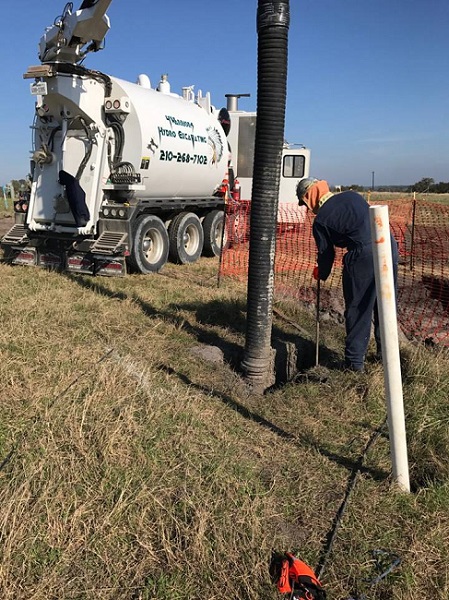5 Easy Facts About Excavator Shown
Wiki Article
Trencher - The Facts
Table of ContentsExcavation Contractors Near Me for DummiesThe Greatest Guide To ExcavatorSome Known Details About Excavation Contractors Near Me All About Excavating ContractorsExcavation Companies Can Be Fun For Anyone


Scrapers or Pans dig deep into dirt in one place, haul as well as unload the dirt in another place (demolition). It is difficult to match the performance of scrapers for cut/fill soil procedure if the haul range is much less after that a mile. Scrapers are typically drawn by a rubber tire wheel tractor and are often pushed with the cut area by an excavator.
There are often times that scrapers are not used for website grading and also a dump truck is used: the haul may be to long, the haul may cross roadways where scrapers are not allowed, acid rock may be encountered, tools availability, and so on. Dump vehicles are in common use and also possibly require little conversation.
Numerous trucks have a top-hinged tailgate that can not unload any type of rock wider after that the tailgate size. "Rock body" beds, on the various other hand, have no tailgates and also can discard any size rock, although their volume ability is reduced. These internet links show equipment requirements for several common dump vehicles. Compaction Tools boosts the density of the soil and also in many cases offers a smooth, rolled surface area.
Some Known Incorrect Statements About Excavation Companies
From a straightforward examination pit to percussion boring to core boring the owner has significantly much more costly alternatives that generate progressively far better information about the site underground. The Proprietor on a 100,000 SF building job might authorize twenty uninteresting locations with split spoon soil examples taken till rock is gotten to and also then core examples of rock.Recognizing the type and top quality of rock (from the core examples) as well as location of rock (from the soils boring) is a real benefit in jobsite planning. Conversely, the Proprietor of a 100,000 SF structure might choose to proceed with no geotechnical testing whatsoever. The choice regarding geotechnical testing is usually made by an Owner without any input from the Construction Supervisor.
A knowledge of the approximate location of the rock aids the Construction Manager to prepare the series of actions following rock excavation. If rock is in one edge of a huge structure project, for example, the earth excavation might begin at the contrary end of the structure in order to begin foundation work soonest.
Beginning the structure job early would be a good idea if the rock can be removed by tearing. Nonetheless, if the rock is very difficult as well as needs significant blasting, it might be sensible to hold foundation work until the blasting is completed. The Construction Supervisor ought to work with these types of choices as well as utilize all the technological date offered.
Excitement About Excavation Companies
Unclassified excavation stipulates that all rock or various see other unanticipated products (omitting harmful materials) encountered in the sitework will certainly be the duty of the Contractor at no modification in agreement cost. An unclassified excavation is less complex from a book-keeping viewpoint and also puts the responsibility for geotechnical problems onto the Sitework Contractor.Just How Water Impacts Sitework? It's fantastic what a heavy rainfall can do to a construction task. Before the rainfall, the site may be completely dry, heavy tools successfully relocating earth, the various other trades smoothly performing their work. Within hours the project can be a careless, mud-hole with worker performance reduced to regarding 10%.
In a lot of areas of the world, the Building Manager must bear in mind a simple fact: IT WILL RAINFALL. Excellent preparation can minimize the damage and disturbance of a hefty rain to a jobsite. Often the excavation as well as grading is delegated the Sitework Service Provider (and also their Foremen is liable to monitor as well as route the heavy devices as well as operators).
The Building and construction Supervisor should be constantly aware of what rain will do to the job website. It is not uncommon for the Sitework Supervisor to function their heavy devices for maximum performance and wish it doesn't rain. One of the very best means to plan for rain is to incline all grades to drain as well as to smooth rolled the surface before a rainfall.
The Ultimate Guide To Excavator
The Building Manager should be well-balanced sufficient to insure that heavy rain does not quit job on the task longer than essential. Daily discussions with Sitework Foremen may be needed to attain this objective. Any kind of time excavation is called for listed below the existing water table on a project, the process of dewatering have to be considered.In a truly natural soil, the water travels so gradually with the clay or silt that dewatering is not typically required for the fairly brief time of excavation. Dewatering might be needed for a single ground excavation or for an entire job site. The most usual dewatering techniques are trench drains, deep wells as well as well points.

Ground water infiltration can additionally be reduced by cutoff techniques such as sheet loading. High dewatering prices have faded the revenue margins on far as well many tasks.
This option ought to always be taken into consideration when evaluating the prospect of dewatering. Undoubtedly the option is just feasible if gravity can run the water to lower ground. Trench drains pipes can be cut with a backhoe as well as filled with a coarse, granular material (# 4 stone as an example), yet care must be exercised in selecting the water outlet kind and also place.
Trencher - An Overview
A siphon, by definition, uses air pressure to lug water from one altitude, up over an obstacle, to a reduced elevation. The pipes in a siphon system should be airtight and some ingenuity is typically called for to entirely fill up the siphon pipe. The siphon pipeline should be full for the siphon to start.A deep well contains a pump, hose as well as an upright well casing. The pump intake is at the bottom of the demolition excavator well covering (generally some smashed stone is positioned down there as a filter tool) (excavating contractors). The water is pumped up the hose pipe, out of the well covering, and also to an ideal discharge place.
In a coarse sand, as an example, a huge area can be pumped to near the pump like it intake altitude. A less absorptive dirt, on the various other hand, lowers the efficiency of a deep well. Given that the pump is typically at the end of the deep well, there are no height restrictions due to vacuum lift, and also deep wells can lower the groundwater over 50 feet.
Under of the wellpoint there is a 2 foot long display and also valve, water jets out of this valve and develops a hole into which the wellpoint pipe can be lowered. This hole is typically made a bigger diameter (as an example 10 inches) to permit a rugged sand backfill to aid filter the water (excavation contractors near me).
Report this wiki page